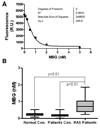Renal ischemia regulates marinobufagenin release in humans
- PMID: 20823380
- PMCID: PMC2959137
- DOI: 10.1161/HYPERTENSIONAHA.110.155564
Renal ischemia regulates marinobufagenin release in humans
Abstract
Cardiotonic steroids, including marinobufagenin, are a group of new steroid hormones found in plasma and urine of patients with congestive heart failure, myocardial infarction, and chronic renal failure. In animal studies, partial nephrectomy induces marinobufagenin elevation, cardiac hypertrophy, and fibrosis. The objective of this study is to test the effect of renal ischemia on marinobufagenin levels in humans with renal artery stenosis (RAS). To test this, plasma marinobufagenin levels were measured in patients with RAS of the Prospective Randomized Study Comparing Renal Artery Stenting With or Without Distal Protection, non-RAS patient controls who were scheduled for coronary angiography, and normal healthy individuals. Marinobufagenin levels were significantly higher in patients with RAS compared with those of the other 2 groups. Multivariate analysis shows that occurrence of RAS is independently related to marinobufagenin levels. In addition, renal artery revascularization by stenting partially reversed marinobufagenin levels in the patients with RAS (0.77±0.06 nmol/L at baseline; 0.66±0.06 nmol/L at 24 hours; and 0.61±0.05 nmol/L at 1 month). In conclusion, we have found that marinobufagenin levels are increased in patients with RAS, whereas reversal of renal ischemia by stenting treatment reduces marinobufagenin levels. These results suggest that RAS-induced renal ischemia may be a major cause of marinobufagenin release.
Trial registration: ClinicalTrials.gov NCT00234585.
Figures





References
-
- Schoner W, Scheiner-Bobis G. Role of endogenous cardiotonic steroids in sodium homeostasis. Nephrol Dial Transplant. 2008;23:2723–2729. - PubMed
-
- Komiyama Y, Dong XH, Nishimura N, Masaki H, Yoshika M, Masuda M, Takahashi H. A novel endogenous digitalis, telocinobufagin, exhibits elevated plasma levels in patients with terminal renal failure. Clin Biochem. 2005;38:36–45. - PubMed
-
- Komiyama Y, Nishimura N, Munakata M, Mori T, Okuda K, Nishino N, Hirose S, Kosaka C, Masuda M, Takahashi H. Identification of endogenous ouabain in culture supernatant of PC12 cells. J Hypertens. 2001;19:229–236. - PubMed
-
- Bagrov AY, Fedorova OV, Dmitrieva RI, Howald WN, Hunter AP, Kuznetsova EA, Shpen VM. Characterization of a urinary bufodienolide Na+,K+-ATPase inhibitor in patients after acute myocardial infarction. Hypertension. 1998;31:1097–1103. - PubMed
-
- Laredo J, Hamilton BP, Hamlyn JM. Ouabain is secreted by bovine adrenocortical cells. Endocrinology. 1994;135:794–797. - PubMed
Publication types
MeSH terms
Substances
Associated data
Grants and funding
LinkOut - more resources
Full Text Sources
Other Literature Sources
Medical

